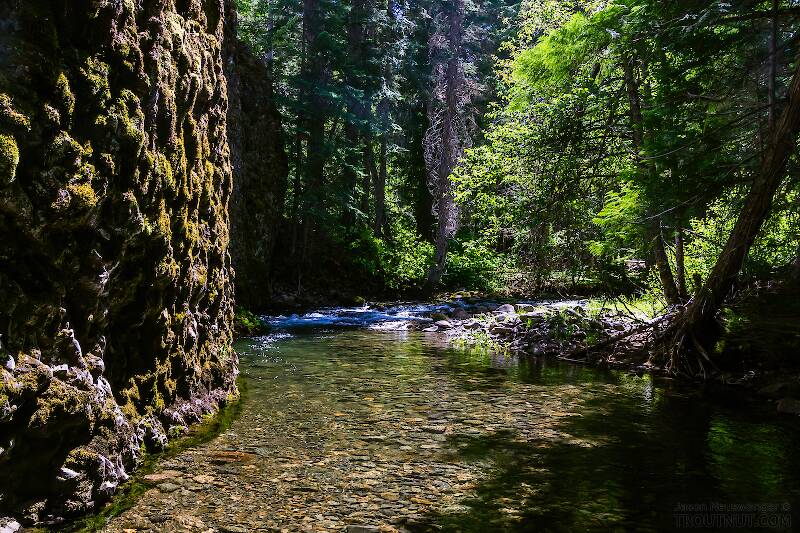
Hex Mayflies
Hexagenia limbata
The famous nocturnal Hex hatch of the Midwest (and a few other lucky locations) stirs to the surface mythically large brown trout that only touch streamers for the rest of the year.


Mayfly Species Drunella cornutella (Small Blue-Winged Olives)
Drunella cornutella looks like a Mini-Me version of Drunella cornuta. In streams where the two species cohabit, size is the only easy way to tell them apart. Although there is some slight overlap between the largest cornutella and the smallest cornuta, the average difference is usually pretty obvious. Both share very similar coloration and morphology in all stages, even down to the little curved horns coming out of the frontal shelves of the nymph's heads.
Where & when
In 25 records from GBIF, adults of this species have mostly been collected during July (72%), August (12%), and April (8%).
In 8 records from GBIF, this species has been collected at elevations ranging from 649 to 2221 ft, with an average (median) of 1519 ft.
Species Range
Hatching behavior
On freestone streams, emergence often happens in the hour or so after dawn. On tailwaters with cold (hypolimnetic) releases in the summer, emergence can sometimes shift to the evening.Spinner behavior
Time of day: Evenings
Habitat: Riffled areas
Juvenile biology
Current speed: Fast to moderate
Substrate: Rocks and gravel
Identification
To determine whether a specimen of Drunella belongs to Drunella cornutella, use the Key to Species of Drunella Nymphs.
Drunella cornutella Fly Fishing Tips
Larger "BWO" imitations used for Drunella cornuta need only be downsized, or "BWO" imitations used for Baetidae can upsized. Nymph imitations fish well during the period before or around emergence, even when opportunities to fish duns or spinners are slight.Physical description
Most physical descriptions on Troutnut are direct or slightly edited quotes from the original scientific sources describing or updating the species, although there may be errors in copying them to this website. Such descriptions aren't always definitive, because species often turn out to be more variable than the original describers observed. In some cases, only a single specimen was described! However, they are useful starting points.
Male Spinner
Wing length: 7 mm
A species of the fuscata group (now a synonym of Drunella walkeri); very close to E. cornuta (now a synonym of Drunella cornuta), but considerably smaller.
Head and thorax deep blackish brown. Pleura tinged with reddish below the bases of the wings. Legs light brown, tinged with ruddy basally. Wings hyaline, venation pale; cross veins almost invisible. Abdominal tergites smoky brown; posterior margins darker brown; dark brown oval patches, rather indistinct, situated laterally. Sternites light olive brown; posterior sternites reddish brown, opaque. Forceps dull brownish, the third joint relatively shorter than in cornuta. Penes as in fig. 153. Tails dull whitish, the joinings faintly reddish brown.
Nymph
Nymph very much resembles a small cornuta (now a synonym of Drunella cornuta), but is darker in color, varying from dark reddish brown to brownish black. The frontal horn is considerably more strongly incurved. The tibial ‘thumb’ of the fore leg is short and blunt, not curving outward as in cornuta. Other structural characters as in cornuta. A dark basal spot is present on the tibia, also a dark median band; tarsus dark basally. Tails yellowish brown.
Start a Discussion of Drunella cornutella
References
- Jacobus, L. M., Wiersema, N.A., and Webb, J.M. 2014. Identification of Far Northern and Western North American Mayfly Larvae (Insecta: Ephemeroptera), North of Mexico; Version 2. Joint Aquatic Science meeting, Portland, OR. Unpublished workshop manual. 1-176.
- Needham, James G., Jay R. Traver, and Yin-Chi Hsu. 1935. The Biology of Mayflies. Comstock Publishing Company, Inc.
Mayfly Species Drunella cornutella (Small Blue-Winged Olives)
Species Range
Common Names
Resources
- NatureServe
- Integrated Taxonomic Information System
- Global Biodiversity Information Facility
- Described by McDunnough (1931)

